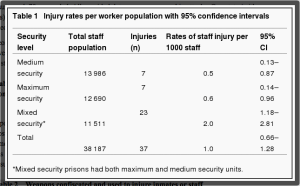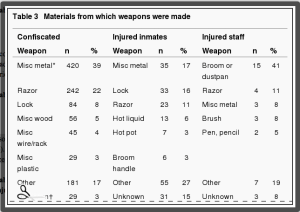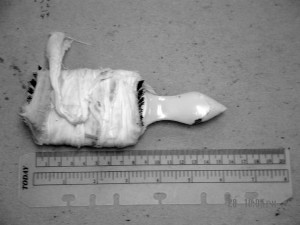Inmate-made weapons in prison facilities: assessing the injury risk

PMC:
More than 2400 correctional workers in the United States required medical attention in 1999 following assaults by inmates, often with unconventional “homemade” weapons. Little information is available about these weapons. The authors surveyed 101 state prisons for a 12 month period within 2002–03, and 70 responded. A total of 1326 weapons were either confiscated (1086) or used to injure inmates (203) or staff (37). Staff were most often attacked with clubs. The prison store was the most common source of materials used to make confiscated weapons. Issued items were the most common source of materials used to make weapons to injure staff. The injury rate for staff was 1.0/1000 workers per year. The annual cost of injuries for time lost and medical care for staff was estimated at $1,125,000 in these 70 prisons. Results identify materials that should be redesigned to prevent modifications to make weapons. Prison stores and issued items deserve special attention.
Keywords: assaults, weapons, inmates, occupational injuries
Contact with violent inmates creates hazards in the correction officer’s workplace that are rare for other professions. More than 2400 correctional workers in the United States required medical attention in 1999 following assaults by inmates,1 often with unconventional “homemade” weapons.
Items that appear innocuous have been converted into weapons that maimed and killed correction officers. Examples include padlocks, toothbrushes, disposable razors, metal from ventilators, batteries, and even paper hardened with toothpaste and sharpened. These items come from the prison store, prison industries, and visitors, or have been salvaged from prison facilities and modified into daggers, shanks (homemade knives), darts, and saps (see fig 11).2
Figure 1 Hairbrush modified into a stabbing device.
In the mid‐1990s, a survey was conducted of facilities in the southern US to explore the problem of inmates making weapons from prescribed medical devices such as knee braces. Thirty four percent responded that medical devices had been “used or altered in a criminal manner”.3
The objectives of the present study were to (1) describe the weapons confiscated or used in attacks, (2) determine the incidence of injuries from attacks on correctional staff, and (3) determine the resulting cost and time lost due to these injuries. The results of this study identify materials and objects that should be redesigned to prevent modification to inflict injury. This problem is not likely to be unique to the US—violent inmates in any country can create hazards in the form of homemade weapons. It is important to recognize the problem of inmate‐made weapons and to decrease the source materials for these weapons.
Methods
We conducted a survey of medium and maximum security state prison facilities across the country for a 12 month period within 2002–03. All 50 states were invited to participate and 13 states agreed to. There were 187 prisons in these 13 states, from which a random sample of 101 facilities was selected.
A survey form was developed that requested facility information regarding number of employees and inmates. The survey form also requested descriptive information about the weapons that were confiscated or used in assaults, which included what the weapon was made from and the source of this material. Time lost from work and hospitalization was recorded for injured correctional staff.
We contacted the warden at each facility and worked with the person he/she specified. This designated person completed the survey form based upon information in the prison incident reports. These reports were usually hard copy reports at each facility.
To estimate lost workdays and costs of staff injuries, weights were based on sampling fraction of prison facilities by security level for each state. Lost wages were calculated by multiplying the weighted number of lost workdays by the mean daily wages for “correctional officers and jailers” of each state based on the 2002 Bureau of Labor Statistics. If a state estimate was not available, the US average salary for this occupation was used.
The weighted number of hospitalized and non‐hospitalized injuries for correctional staff was multiplied by a published figure for the average cost of a hospital admission and doctor/clinic visit.4 We assumed that all non‐hospitalized injuries were doctor/clinic visits.
The Johns Hopkins University, Bloomberg School of Public Health, Committee on Human Research approved the study protocol.
Results
Of the 101 prisons surveyed, 70 responded. All provided data on weapons used in attacks. One state (with 16 sampled facilities) did not provide information on confiscated weapons but its data on attacks and injuries were included in analyses.
The injury rate for correctional staff was 1.0/1000 workers (table 11).). Prisons having both maximum and medium security levels (“mixed security”) had the highest injury rates for both staff and inmates. Four of the 10 participating states said they had no staff injuries, but were included in the denominators for rates.
Table 1 Injury rates per worker population with 95% confidence intervals
A total of 1326 weapons were either confiscated (1086) or used to injure inmates (203) or staff (37) (table 22).). The weapons most commonly confiscated were shanks (homemade knives), daggers, and razors. The weapons most commonly used to injure inmates were shanks, clubs, and saps (for example, padlocks in socks). The weapons most commonly used to injure staff were clubs, daggers, and razors. “Clubs” included unmodified objects such as pitchers, hot pots, and broom handles.

Table 2 Weapons confiscated and used to injure inmates or staff
Weapons that were confiscated or used to injure inmates were most commonly made from miscellaneous metal, razors, and padlocks (table 33).). Weapons made from brooms, dustpans, and razors were used to inflict the most injuries on staff.

Table 3 Materials from which weapons were made
The most common source of materials for weapons that were confiscated or used to injure inmates was the prison store (table 44).). Staff supplies as well as items issued by the prison, such as toothbrushes, were the most common source of weapons that injured staff.

Table 4 Source of materials for weapons confiscated and used to injure inmates and staff
During the 12 month survey period, an estimated 2531 workdays were lost at these facilities due to staff injuries. The estimated cost of lost wages was $403,900. A conservative estimate of associated medical costs for staff injuries is $721,400. Lost wages and medical costs of staff injuries from weapons used by inmates in these 70 prisons amounted to $1,125,300.
Discussion
Confiscated weapons were usually cutting or piercing instruments (83%, razors, shanks, and daggers). Most weapons used in attacks on staff were blunt objects that could be classified as weapons of opportunity (for example, broom handle, pitcher). One reason for the difference in weapons confiscated versus those used in attacks is that weapons of opportunity are not considered weapons until they are used to injure. In addition, weapons that were confiscated could have been made just for defense or intimidation purposes and not intended for use in an attack.
The annual injury rate of injury to staff from inmate‐made weapons was 1.0/1000 staff. The overall annual non‐fatal injury rate for workers in the US is 54/1000 full time workers.5 Our injury rate is not comparable because it reflects only those injuries workers received as a result of an assault using a weapon and does not include injuries from all assaults or other work related injuries such as those related to falls. Therefore, this injury rate is not an overall estimate of non‐fatal injury.
The cost estimate is conservative and does not include non‐monetary losses such as pain, family dislocation, and changes in the quality of life. In addition to staff injuries, the 203 injured inmates incurred costs for medical care plus staff time to accompany them to outside medical facilities.
Previous studies of violence among prison populations recommended that eating utensils, prison industry tools, and office devices be redesigned because of their frequent use in acts of violence.6 In conjunction with our study, the Applied Physics Laboratory at Johns Hopkins University (JHU/APL) is studying materials and mechanical design changes focusing on prison store items most commonly used for weapons, such as disposable razors and toothbrushes. JHU/APL has designed a modified razor blade that retains its form during its intended shaving use, but breaks into tiny pieces if someone tries to disassemble the razor.7
Razors and toothbrushes are typically fabricated from thermoplastic polymers that can be re‐formed using heat to soften the polymer. JHU/APL has shown that standard polymers can be replaced by thermosetting polymers that are semi‐flexible or resilient when cured and cannot be melted and re‐formed. Once fabricated, they retain their shape until they are destroyed, for example by attempts to re‐shape them. The flexible material cannot be sharpened by abrading it, thus limiting inmates’ uses of the material.
Similar materials and design principles can be applied to eating utensils, kitchen tools, and possibly medical items that inmates have access to. In addition, some of the items used as weapons of opportunity, such as broom handles, could be redesigned to minimize their usefulness as weapons.
Limitations
All states were asked to participate, but only 13 states wished to do so. Since states were self‐selected rather than randomized, these findings cannot be generalized to the rest of the country. The states and facilities that participated in the survey may be very different from those that did not. However, this cross sectional survey does provide useful information in the type of weapons used and sources of weapon making material that can be modified.
Weapons data, although recorded, were not originally documented by the correctional facilities for the study purpose. Across facilities, there may be different weapon confiscation policies, so there may be more weapons than those actually confiscated or recorded. Facilities may also have different procedures once weapons are confiscated. Any burdensome paperwork provides incentive not to document each weapon confiscated.
Recommendations
The following recommendations were developed based on these survey results. A centralized reporting system and consistent reporting policies for confiscated weapons and weapon related injuries in prisons should be established to identify the most serious threats. In 1988, the National Academy of Sciences assessed violence in the US. One recommendation called for the establishment of an injury surveillance system in prisons to collect information on violent events and help direct risk factor research leading to interventions.8 Such a surveillance system should include information on weapons confiscated or used in attacks.
Facilities should seek to reduce staff injuries and the risk of inmate‐on‐inmate violence. State and federal governments must provide the funding to ensure that both inmates and correctional staff are secure.9Anecdotal evidence suggests that many confiscated weapons are for defensive purposes. Policies altering interaction among inmates and staff members’ response to fights, as well as environmental measures such as eliminating blind spots and private showers, may reduce injury rates.10,11
Our results provide guidance for identifying materials that should be eliminated or redesigned to prevent modification into weapons. The materials research at JHU/APL is promising. Prison store items such as razors and padlocks deserve special attention because prisons control their availability. Prisons are controlled environments and therefore can reduce the sources of materials for weapons.
Acknowledgements
The authors would like to thank all of the correctional staff that participated in the survey and the consultation group with whom we met throughout the study period. We would also like to acknowledge Gwen Bergen and Janani Venkateswaran for their assistance in data entry, cleaning, and coding. The Applied Physics Lab staff members who assisted in this project include Emily Ward and Jack Roberts and the technical support staff from JHU/APL includes Steve Main, Antonio Munoz, Gary Peck, and Bob Wright.
Abbreviations
JHU/APL – Applied Physics Laboratory at Johns Hopkins University
Footnotes
This research was funded under grant #2002‐IJ‐CX‐K017 from the Department of Justice to the Johns Hopkins University Applied Physics Laboratory and in part by the Centers for Disease Control and Prevention, Center for Injury Prevention, and Control Grant #CCR302486.
Competing interests: none.


